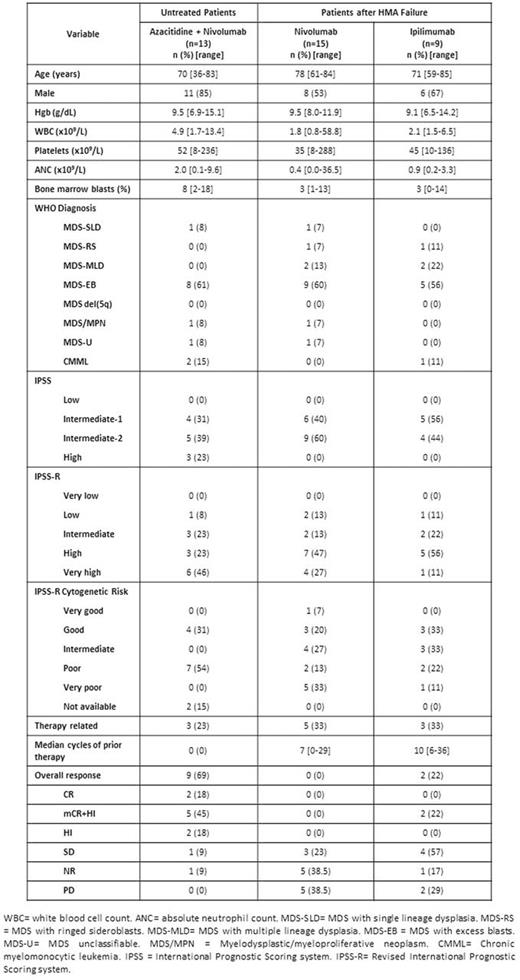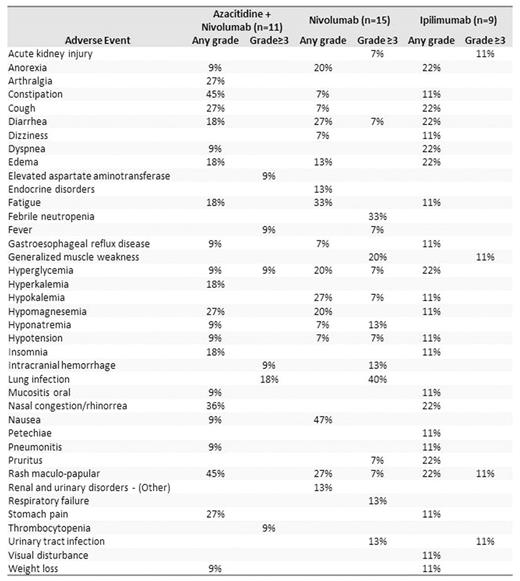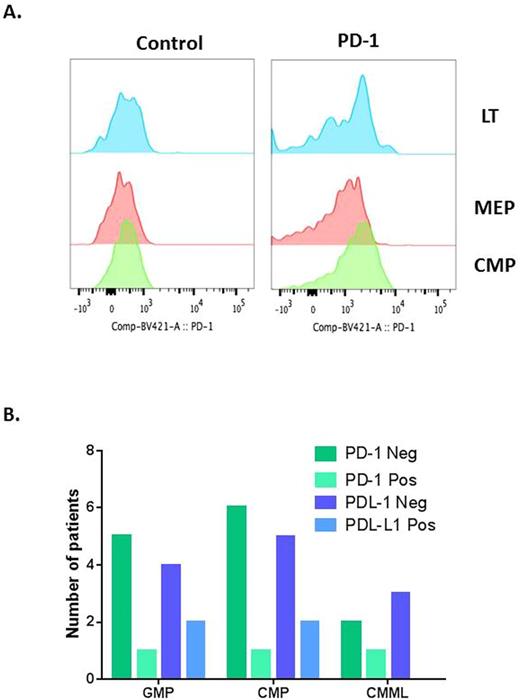Abstract

INTRODUCTION: Outcomes of pts with MDS after hypomethylating agent (HMA) failure remain poor. Improving the response and survival of pts with higher-risk MDS and developing treatments for pts after HMA failure is needed. Upregulation of PD-1, PD-L1 and CTLA-4 in MDS CD34+ cells after exposure and loss of response to HMA have been reported (Yang, Leukemia 2014). Nivo and Ipi are monoclonal antibodies targeting PD-1 and CTLA-4, respectively, with clinical activity in solid tumors. We hypothesized that use of these drugs after HMA failure or in combination with azacitidine (AZA) in the frontline setting may improve treatment outcomes of pts with MDS.
METHODS: We designed a phase II study of Nivo or Ipi in monotherapy or combination for pts with MDS. Pts with prior therapy with HMA were to be treated in one of 3 consecutive cohorts: cohort #1: Nivo 3mg/kg iv days 1 and 15 of a 28 day cycle; cohort #2: Ipi 3mg/kg iv on day 1 of a 21 day cycle; cohort #3: Nivo 3 mg/kg iv on days 1 and 15 + Ipi 3 mg/kg iv on day 1 of a 28 day cycle. The study design allowed for AZA add-back after 6 cycles of therapy if there was no response or progression. Pts with previously untreated MDS were to be treated in one of 3 consecutive cohorts combining AZA 75mg/m2 iv daily days 1-5 of a 28 day cycle in each cohort with: cohort #4: Nivo 3mg/kg iv Days 6 and 20; cohort #5: Ipi 3mg/kg iv on day 6; and cohort #6: Nivo 3 mg/kg iv on days 6 and 20 + Ipi 3 mg/kg iv on day 6. The maximum size per cohort is 20 pts. The primary endpoint is to determine the safety of Nivo or Ipi as single agents or in combination with AZA. Secondary objectives included overall response rate (ORR) and assessment of biological activity. Responses were evaluated following the revised 2006 International Working Group (IWG) criteria. The study included stopping rules for response and toxicity. Adverse events (AEs) were assessed and graded according to the CTCAE v4 criteria.
RESULTS: A total of 39 pts were registered between September 2015 and July 2016, with 2 enrollment failures, 13 (35%) treated with frontline AZA+Nivo, and 15 (41%) and 9 (24%) with Nivo or Ipi after HMA failure, respectively. Thirty-five pts (95%) are evaluable for toxicity and 33 (89%) for response at the time of analysis. Patient characteristics are shown in Table 1. The median number of treatment cycles was 4 (range 2-11) in pts treated with AZA+Nivo, 3 (1-8) in the Nivo cohort, and 3 (2-4) in the Ipi cohort. A total of 25 (71%) pts experienced at least one AE during therapy (Table 2), with 3 (27%) pts in the AZA+Nivo cohort, 6 (40%) in the Nivo cohort, and 3 (33%) in the Ipi cohort having related grade ≥3 non-hematologic AEs. Therefore, the stopping rule for toxicity was not met in any of the cohorts. Delays of therapy due to AEs were required in 9 pts due to: rash (N=1), adrenal insufficiency (N=1), colitis (N=1), thyroiditis (N=2), pneumonitis (N=3), and nephritis (N=1). Early 8-week mortality occurred in 1 patient due to a non-related intracranial hemorrhage. The ORR was 69% (6/11) in the AZA+Nivo cohort including 2 CR, 5 mCR+HI, and 2 HI. The ORR was 0% and 22% (2/9) in the Nivo and Ipi arms, respectively (p=0.156). Therefore, the stopping rule for response was met on the Nivo arm, and enrollment after patient 15 was stopped. A total of 4 and 1 pts required addition of AZA due to lack of response on the Nivo and Ipi arms, respectively. At the present time of follow up, 18 (49%) pts remain on study, with 3 having been taken off study due to death (all in the Nivo arm), 3 due to no response (AZA+Nivo: 1; Nivo: 2), 6 due to progression to acute leukemia (AZA+Nivo: 1; Nivo: 4; Ipi: 1), 1 due to transplant, and 1 due to side effects from therapy in the Ipi arm. Immunophenotypic analysis of stem cell and progenitor compartments (Figure 1A) was performed in 27 pts, including PD-1 and PD-L1 expression analysis in 16 pts. Increased PD-1 and PD-L1 expression on progenitor and stem cell compartments was observed in 3 and 4 pts, respectively (Figure 1B). Treatment with PD-1 inhibitors could not overcome the aberrant differentiation patterns. No differences in response were observed based on PD-1 bone marrow expression.
CONCLUSION: Preliminary results indicate that PD-1 blockade with Nivo in combination with AZA in untreated higher-risk MDS pts is associated with a tolerable safety profile and clinical activity. Single-agent Ipi is capable of inducing responses in previously treated MDS pts. Single-agent Nivo did not show clinical activity. Further follow-up is needed to update efficacy and safety data.
Jabbour:ARIAD: Consultancy, Research Funding; Pfizer: Consultancy, Research Funding; Novartis: Research Funding; BMS: Consultancy. DiNardo:Novartis: Research Funding; Abbvie: Research Funding; Celgene: Research Funding; Daiichi Sankyo: Research Funding; Agios: Research Funding. Cortes:ARIAD: Consultancy, Research Funding; BMS: Consultancy, Research Funding; Novartis: Consultancy, Research Funding; Pfizer: Consultancy, Research Funding; Teva: Research Funding.
Author notes
Asterisk with author names denotes non-ASH members.

This icon denotes a clinically relevant abstract




This feature is available to Subscribers Only
Sign In or Create an Account Close Modal